1lumen selects and reviews products personally. We may earn affiliate commissions through our links, which help support our testing.
Maratac LEP DX Reach Rev2 review

Maratac DX Reach Rev2 specifications
| Brand/model | Maratac DX Reach Rev2 |
|---|---|
| Flashlight category | LEP / long-range / tactical / searchlight |
| LEP | LEP module |
| Max. output | 600 Lumens |
| Max. beam distance | 1,892 meters |
| Max. beam intensity | 895,000 cd |
| Battery config. | 1*21700 |
| Onboard charging | N/A |
| Modes | 2 |
| Blinkies | Strobe |
| Waterproof | IPX8 |
| Review date | August 2023 |
Review intro:
Maratac has been a name, familiar to the flashlight world, for many years. In the past, Maratac had some popular lights, used by flashoholics, but in the past few years, they weren’t much of a topic of interest.
But maybe this will change it?
We are talking about the Maratac LEP DX Reach Rev2, which, as the name implies, uses an LEP module instead of an LED. And for those of you, unfamiliar with this term, it’s basically using a blue laser, turning it into white light by shining its beam onto/through a layer of phosphor.
This results in a pretty tight and intense beam, close to what an LED flashlight would do.
Package quality.
The DX Reach was sent in a translucent plastic box with a few basic accessories. This is what you can find inside the box:
- The flashlight: Maratac LEP DX Reach rev2
- Glow tubes
- O-rings
- 18650 battery adapter
This is enough for this type of light, but adding a manual would have been nice. You can find the manual online, or just read it in the UI section of this review.
I bought mine second hand in the Netherlands, (which still seemed to be unused) so it is possible that the manual was removed before sending? No idea.
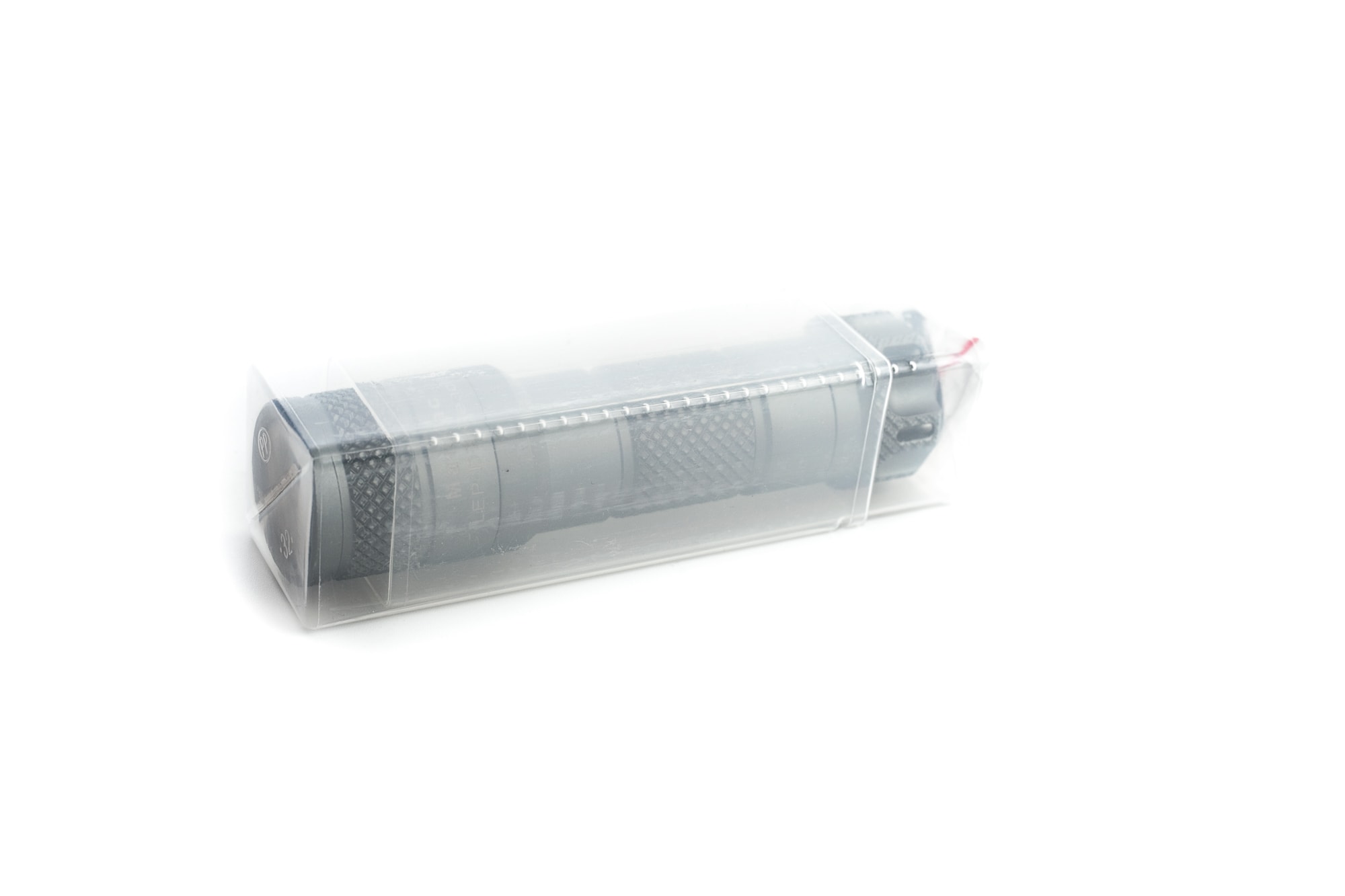

Flashlight in use
The LEP Reach is a 21700 LEP flashlight with knurling on the head, battery tube and tailcap. And I like the way it looks, but it also give a firmer grip.
Having said that, unfortunately, it was the only flashlight I accidentally dropped during a massive 22 LEP flashlight comparison a while ago. But I don’t think it was the fault of the light, but mine.
The DX Reach has a single reverse-clicky switch, located in the rear end of the flashlight. This is great for use in the overhand position, where your thumb is resting on the switch. In the underhand position, you need to change hand position or use your other hand to (de)activate the light.
This actually has been the case for most flashlights every produced, so shouldn’t be a problem for most use cases. With the intended purpose in mind, I would say it’s great to use as a beacon while hiking, but great for spotting wildlife, and probably even for hunting.
The package didn’t include a lanyard, nor a holster, or pocket clip, you could make one yourself. The tailcap has some holes for a lanyard, and it should fit many holsters. And the only difficulty I could foresee is finding a pocket clip that fits.
The tailcap is also designed with some cutouts, and 6 holes for glow tubes, which are included in the package. These are not tritium vials that can glow for 10+ years, but glow in the dark tubes, that will glow for several minutes, after ‘charging’ them.
By the way, none of the cutouts of the tailcap are helping as an anti-roll feature, so it will roll off a table. But the tailcap is designed so it can tailstand, which can be a great con.
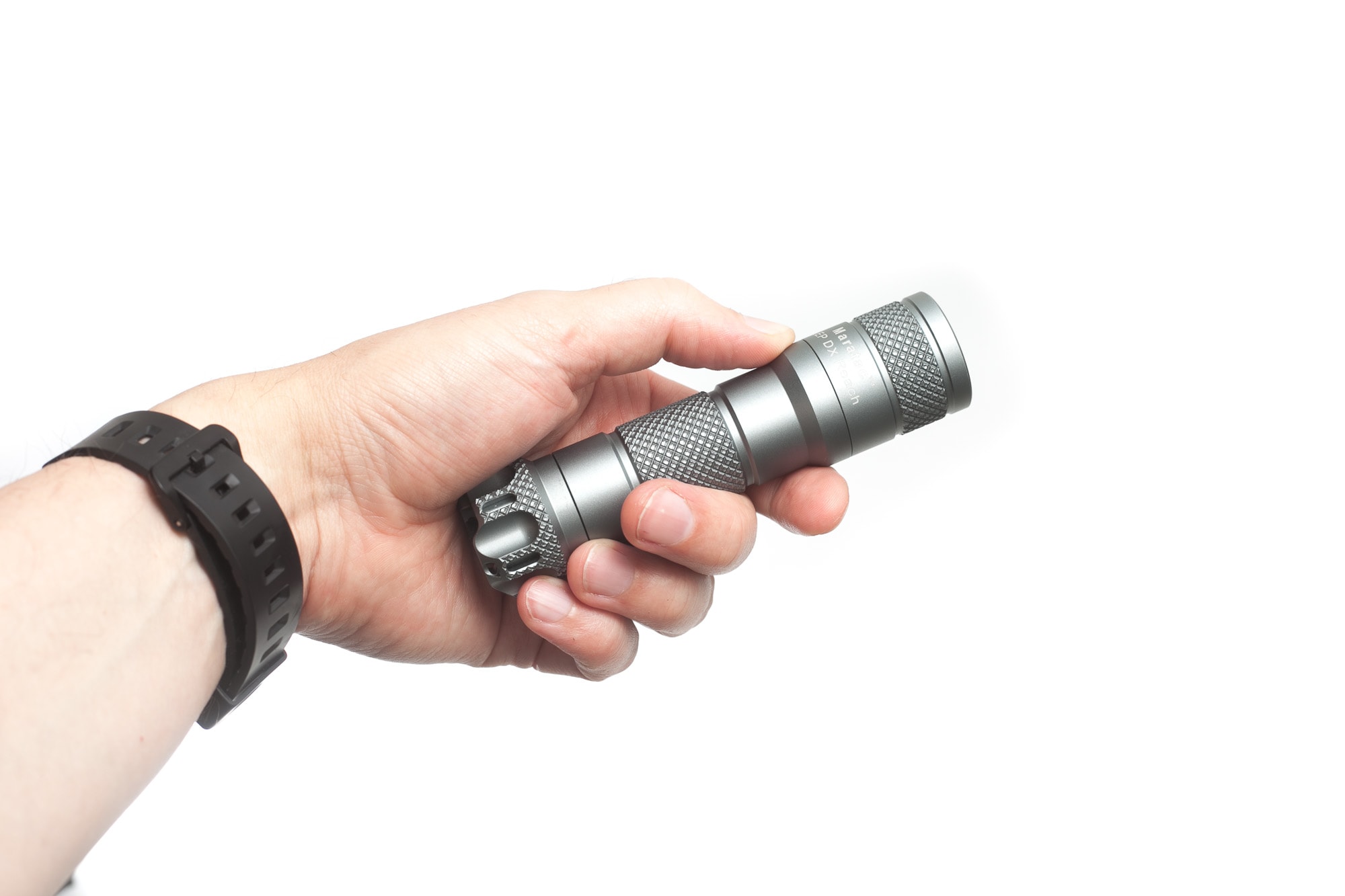
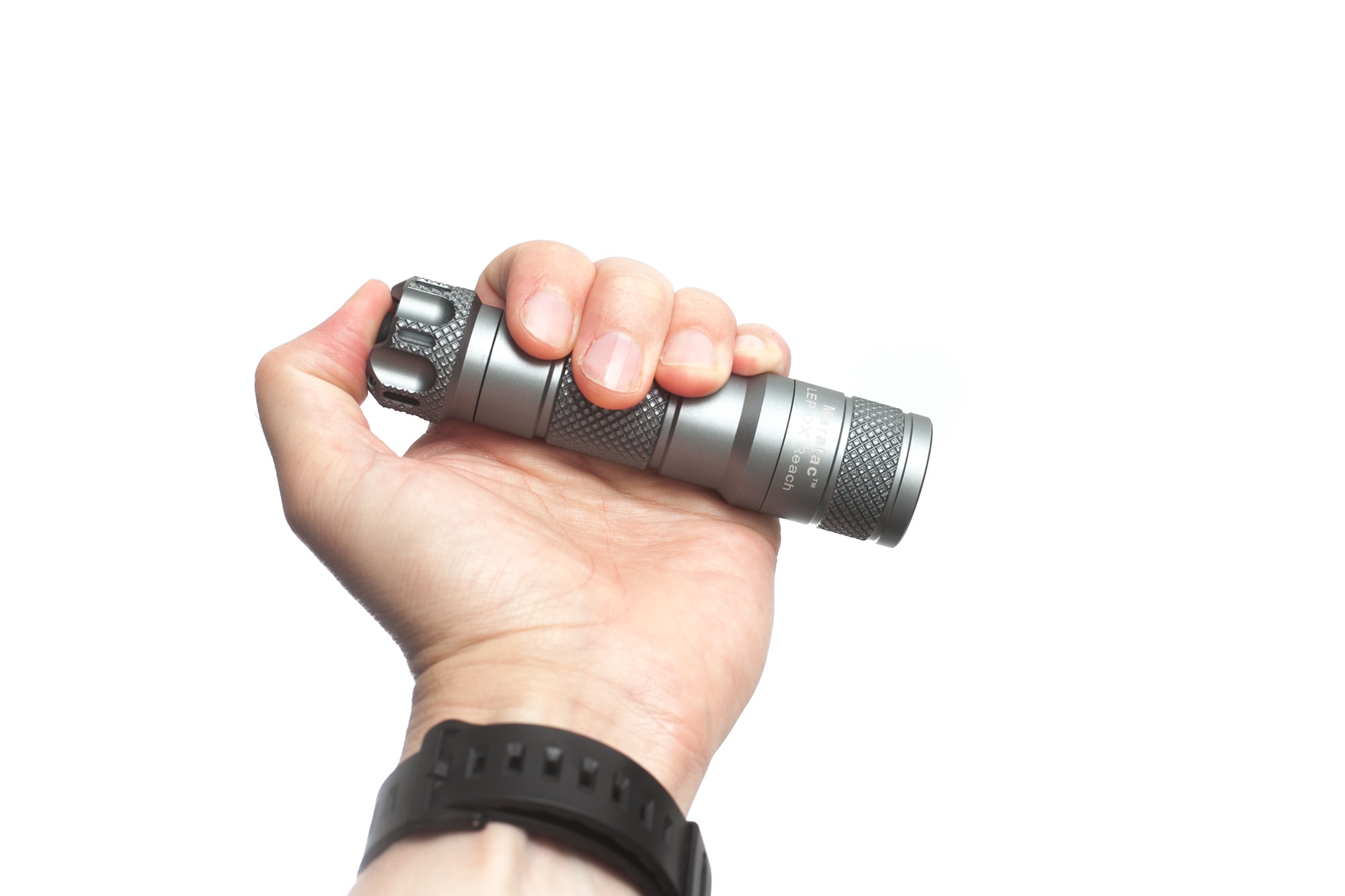
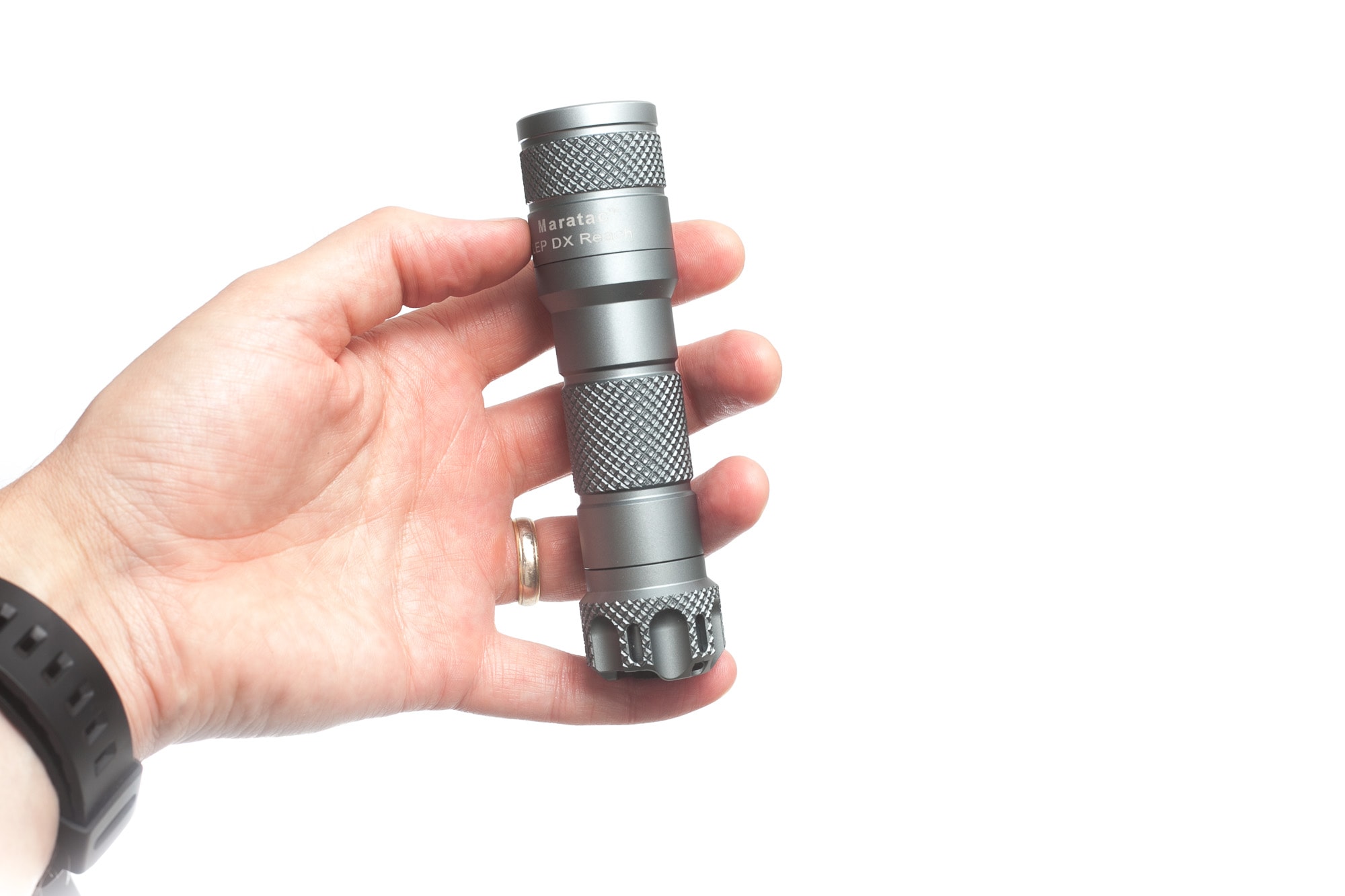
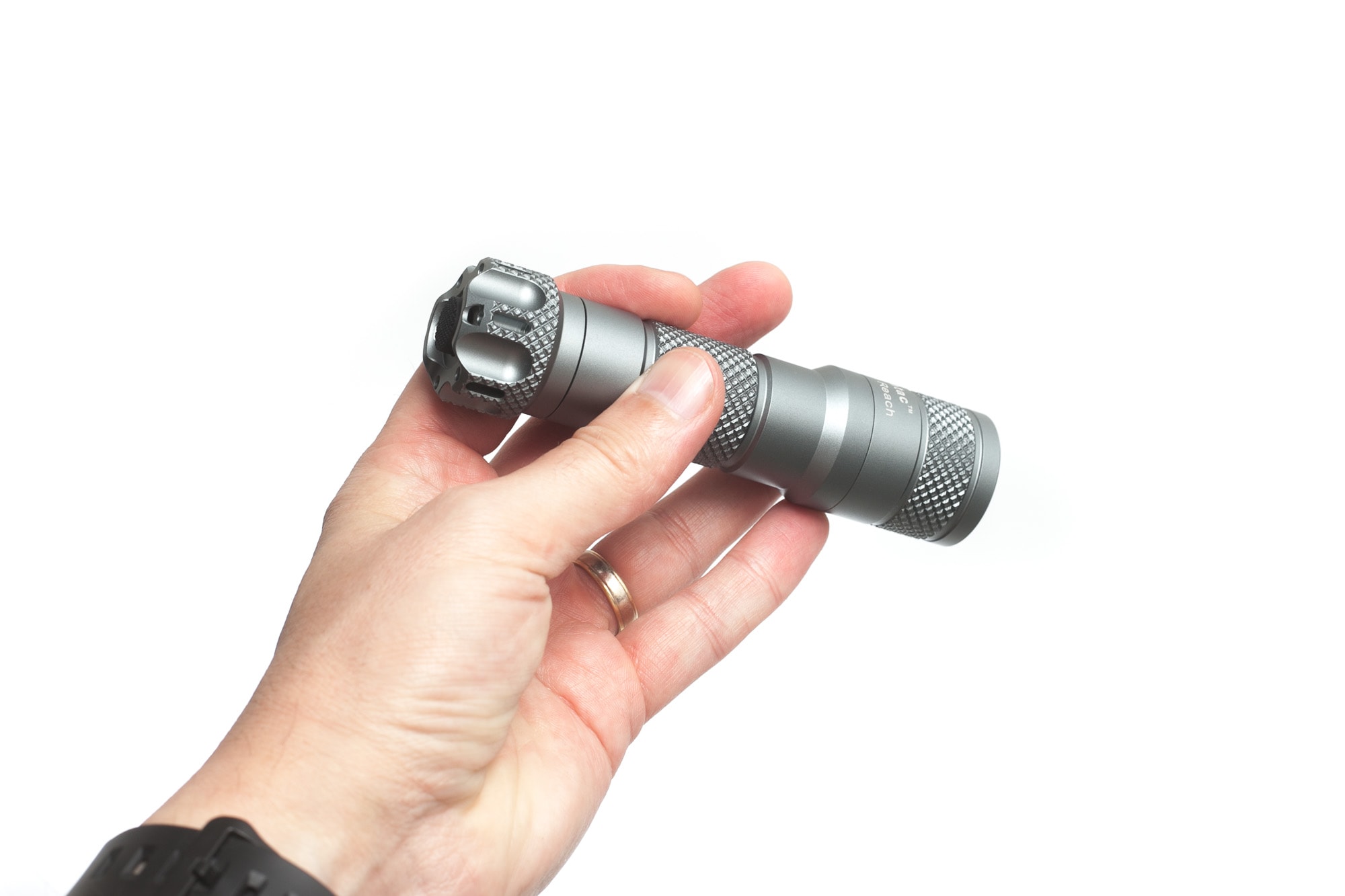
Build Quality and Warranty
At first glance I would say it to be a Lumintop flashlight. And that’s not completely untrue, because it has some characteristics found on Lumintop lights, and likely built by the same manufacturer. It has the typical gray anodization, often seen on Lumintop branded lights.
There is no indication on what type of anodization is used, but from dropping the light onto asphalt, the damaged parts are still gray :–) And I don’t think Maratac (Countycomm) will be producing any other colors.
The knurling pretty aggressive, and I quite like this, especially on this type of light. I don’t mind it on keychain lights, because that’s another story.
Removing the tailcap reveals bare aluminum threads, that make a mechanical lockout impossible. But no worries, because the switch is also a mechanical switch, and therefore won’t discharge the battery when turned off.
It uses a spring in the tailcap as well as on the driver side, but they are short, and you can’t use any long 21700 batteries.
And according to the website of Countycomm, they give the following warranty:
- Full 365 day warranty on all items we sell from defect or failure. We stand behind every product we sell 100% from watches to flashlights, we have you covered!


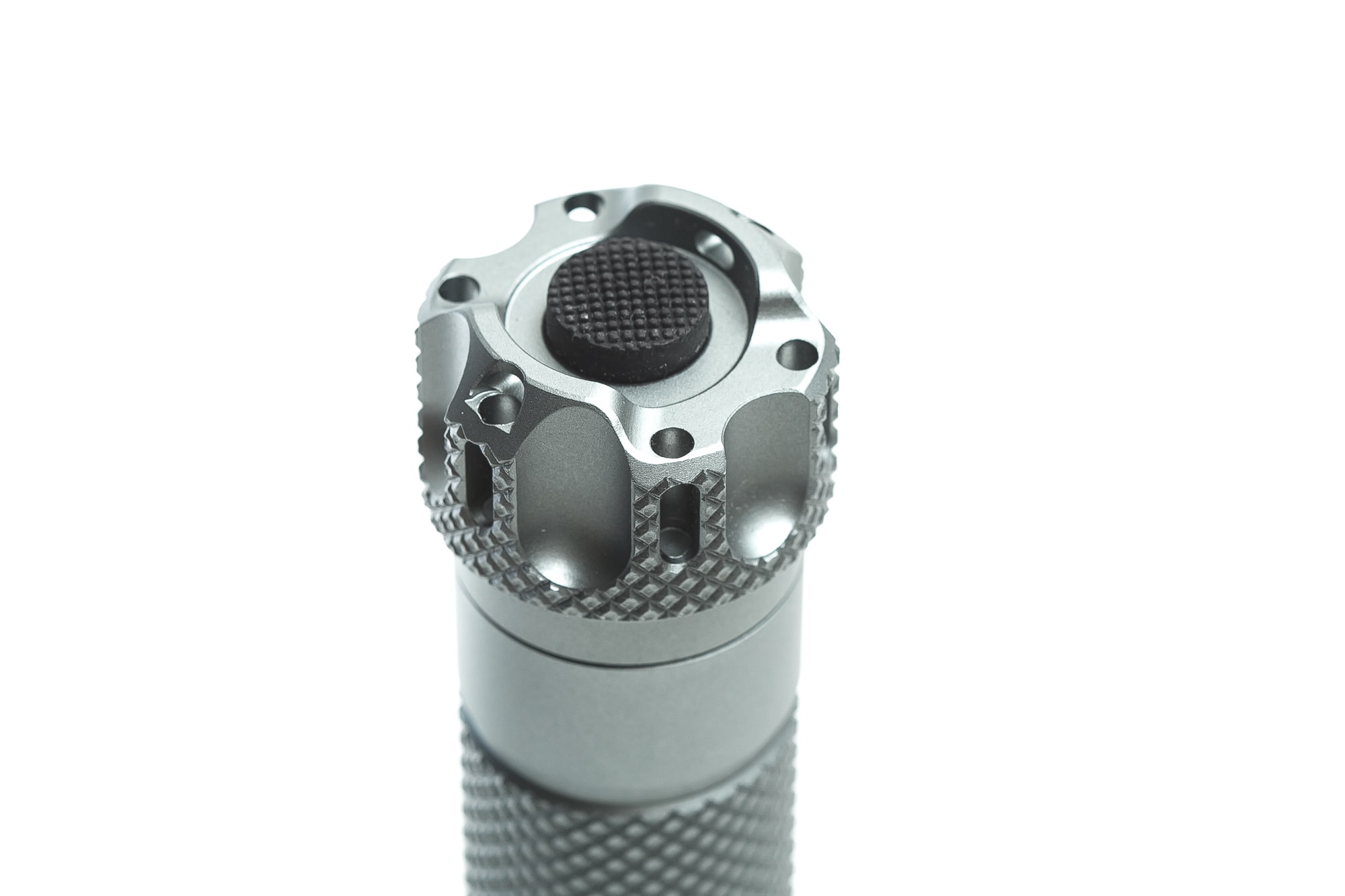
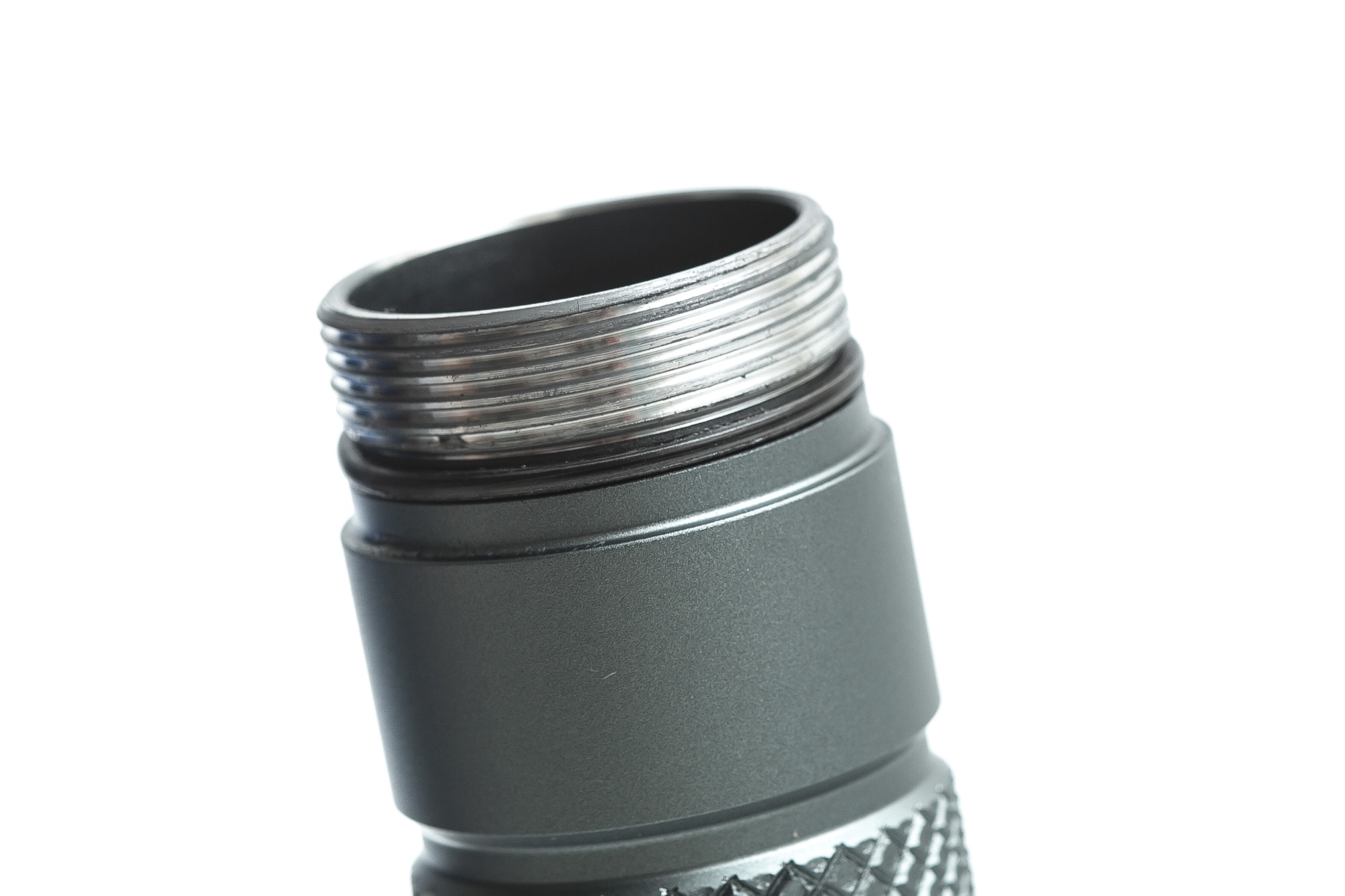
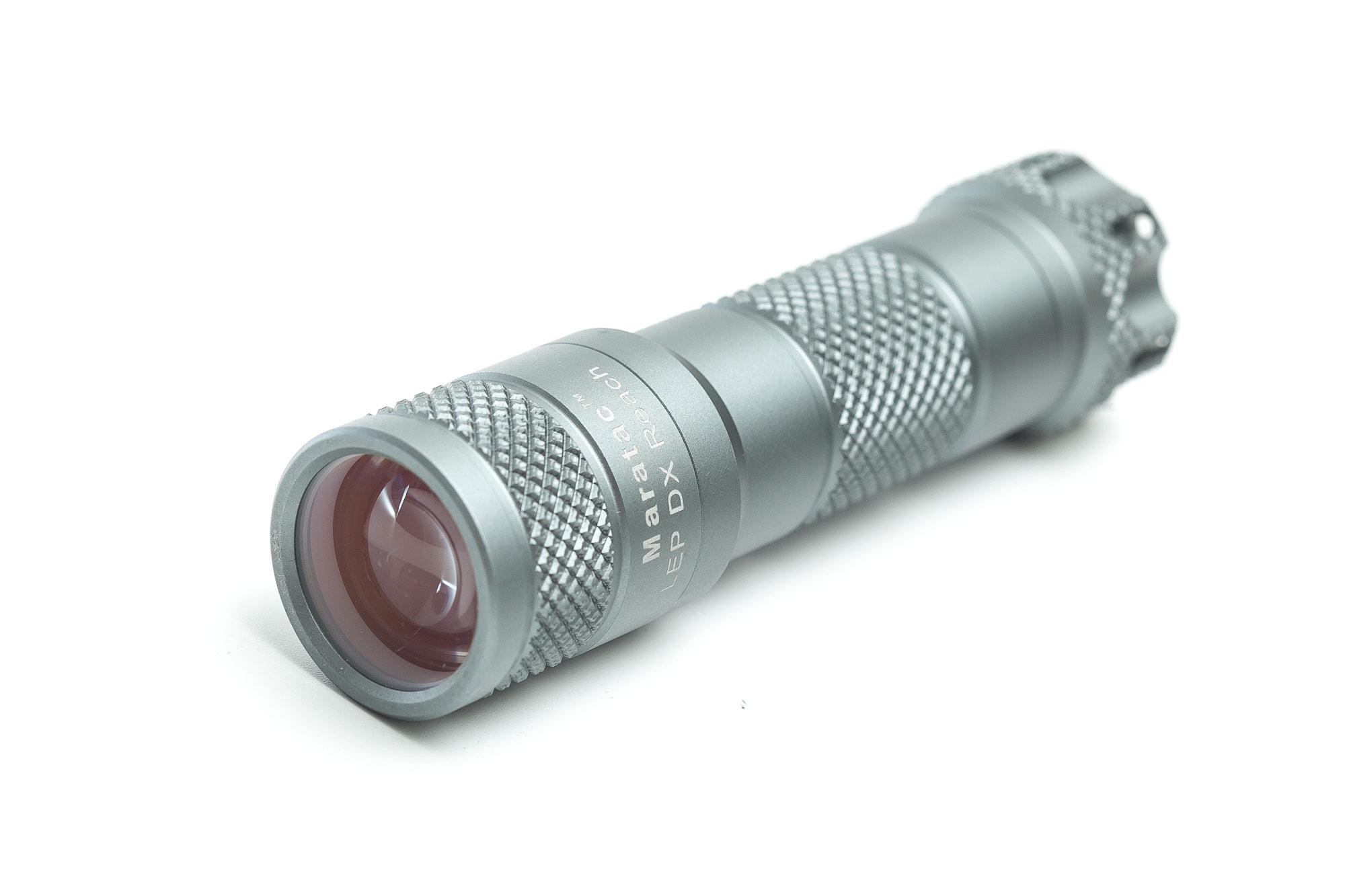
LEP, Lens, Bezel, Beam, and Reflector
The Maratac LEP DX Reach Rev2 is just like its older sibling an LEP flashlight. This means that the light source is a laser instead of an LED chip.
LEPs are currently available with 2 types, namely a mirror-type and shine-through type. The mirror type uses a much bigger module (plastic), while the newer type is the shine-through, where the laser shines through a layer of phosphor to turn the blue laser into a white-ish beam. The DX Reach uses a shine through LEP module.
Until fairly recently, most LEP flashlights were classified as being Class III / Class 3, but these are prohibited in many countries for personal use. And the Maratac is specified as being a Class 2M laser device, and passed CE, RoHS, FDA certifications, according to Countycomm’s website.
Something that I really like about this light is the removable LEP module. You just need to unscrew the bezel, which gives you access to the LEP module, and from there, you can unscrew it. It has about 15 cicular threads, so it takes a bit to remove, but it feels like you can replace it with another module ones it is built. I don’t think this was the purpose of it, but it reminds me of the P60 system, which was popular many years back.
The LEP sits behind a convex lens that turns the beam into a wider beam, and it is protected by a normal glass lens. This is great because if the convex lens gets scratched, it’s much more difficult to find a replacement. And a normal glass lens can easily be replaced, and is also cheaper.
On top of that, there is a glow in the dark ring, inside the bezel, that will glow for a few minutes after the light is turned off. It’s nice to have, but dims fairly quickly.
The bezel itself is made of aluminum, so be careful not to drop it too hard. I dropped mine accidentally during a large LEP video shoot, and it landed on the side, leaving some dents.
The beam is narrow and intense, but is pretty white, without any artifacts, or strange hues. This makes it one of the nicer LEP beams out there. And one of the reasons is definitely the shine-through LEP module. I usually don’t measure the CRI and CCT of LEP flashlights, so I will leave that out here as well.
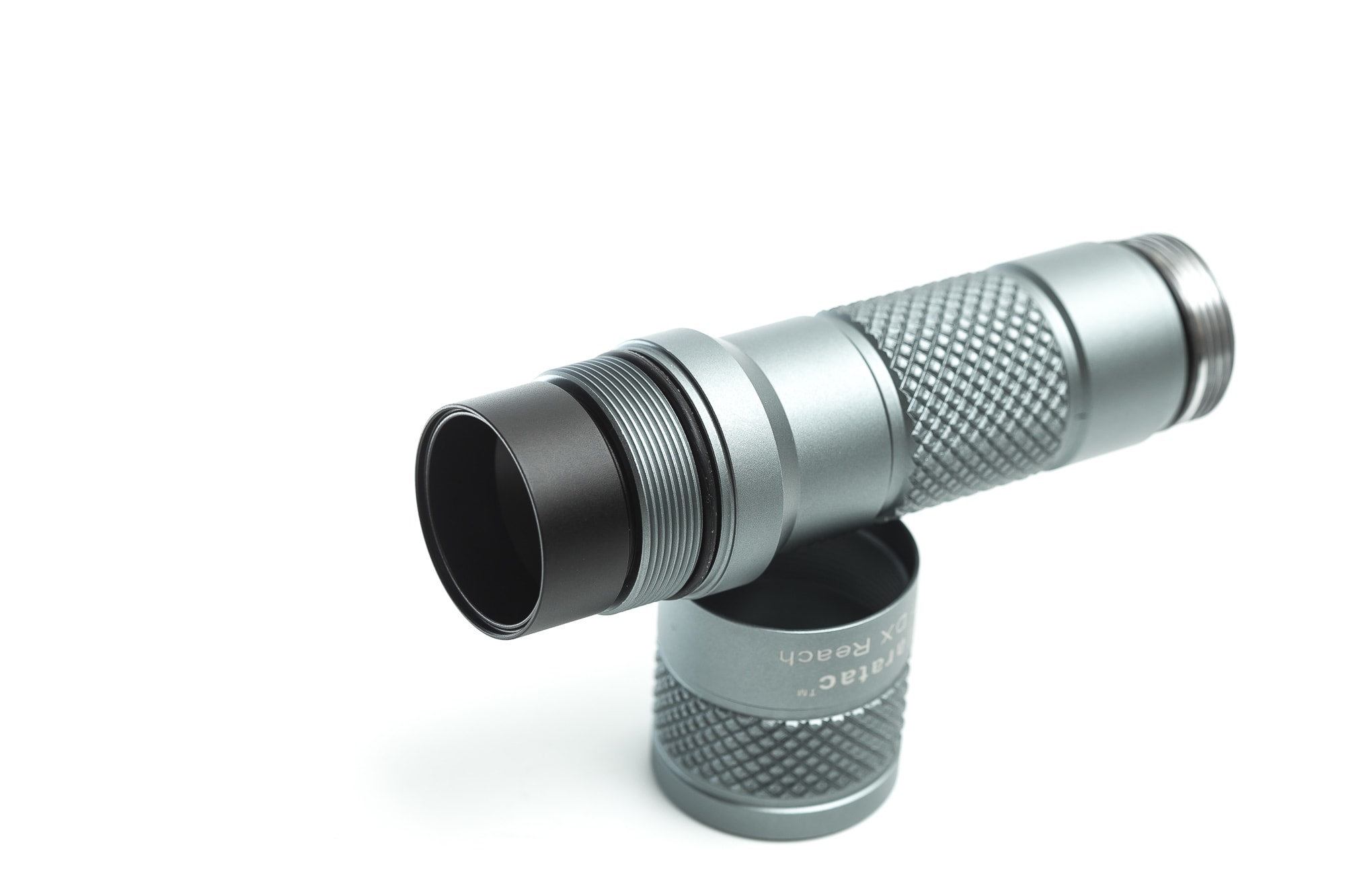
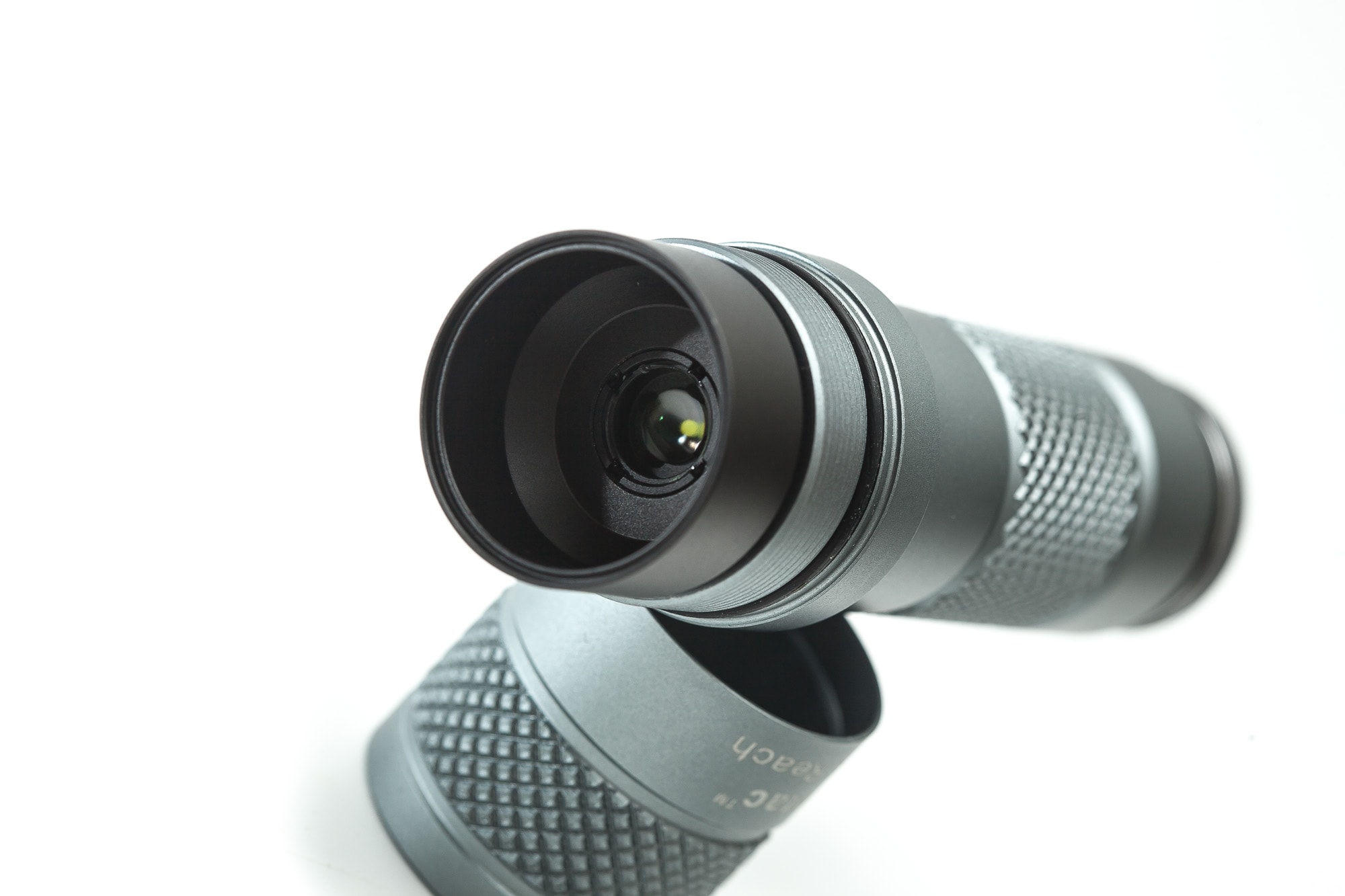
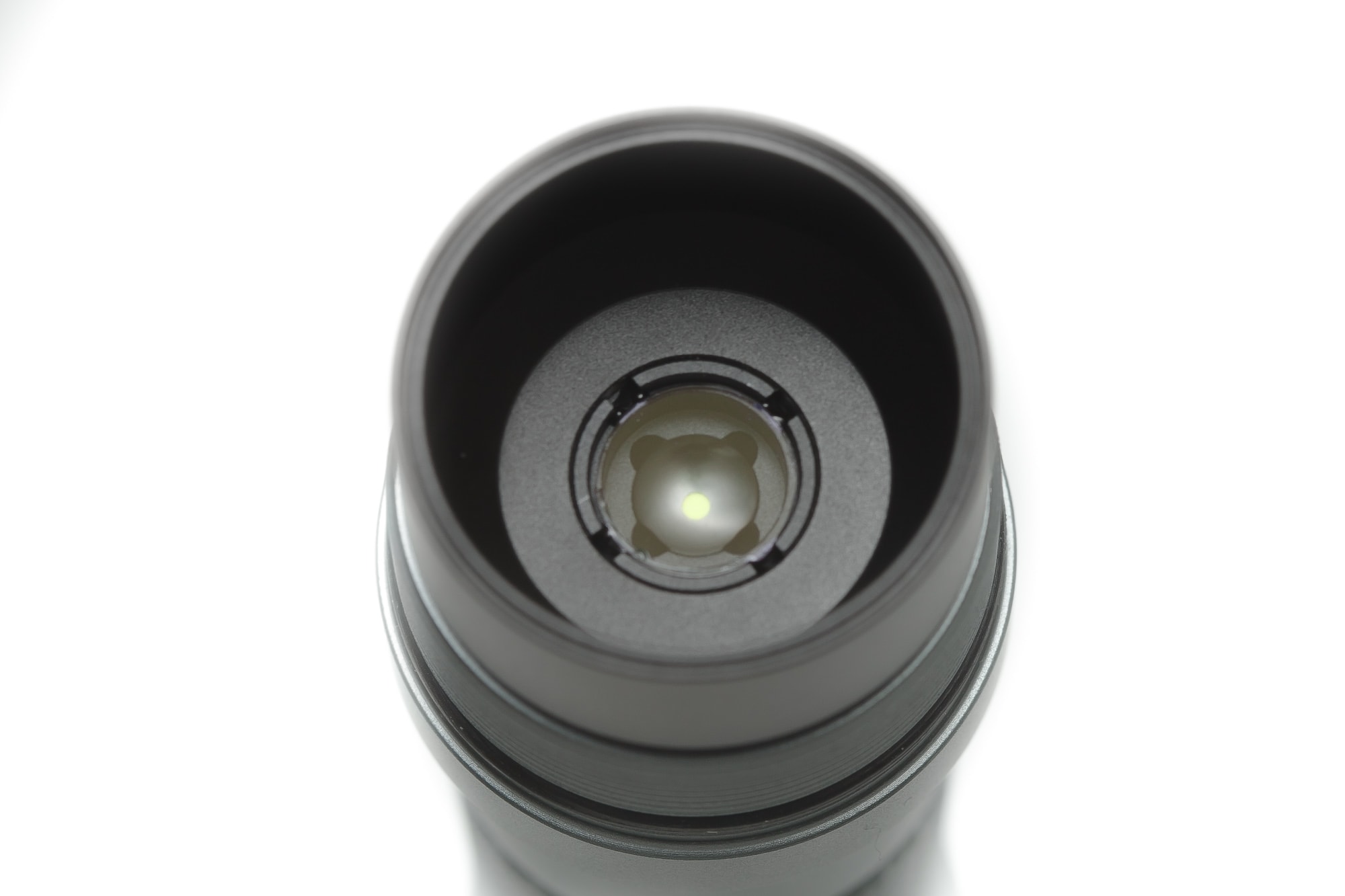
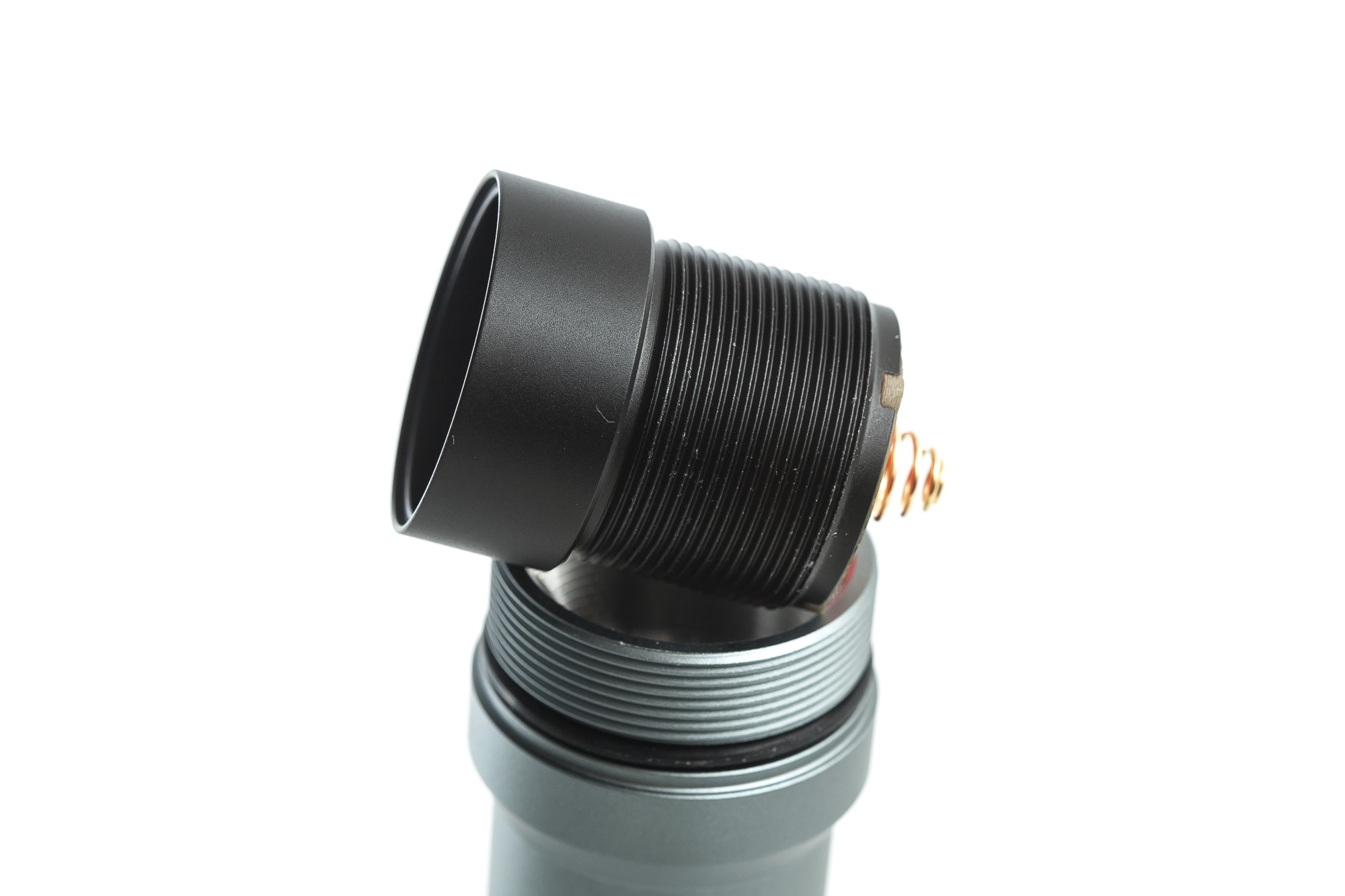
Dimensions and its competition
Dimensions:
| LEP DX Reach | Millimeters | Inches |
|---|---|---|
| Length | 128 mm | 5.1 in |
| Head diameter | 32 mm | 1.25 in |
| Body diameter | 27 mm | 1.07 in |
Dimensions are rounded to the nearest millimeter, and to the nearest tenth of an Inch.
Weight:
Measured with Samsung INR21700 50G battery
| LEP DX Reach | Weight in grams | Weight in oz. |
|---|---|---|
| Without battery: | 110 g | 3.9 oz |
| With battery | 179 | 6.3 oz |
Weight is rounded to the nearest gram, and to the nearest tenth of an Oz.
Maratac DX Reach Rev2 Flashlight comparison
Size compared to other LEP flashlights
Group 1, from left to right: Fenix HT30R, Weltool W3 Pro Tac, NEXTORCH T10L, Mateminco FW3, Maratac DX Reach, Lumintop Thor 2 v1, Weltool W3 Pro, Acebeam W10 II, Fenix TK30
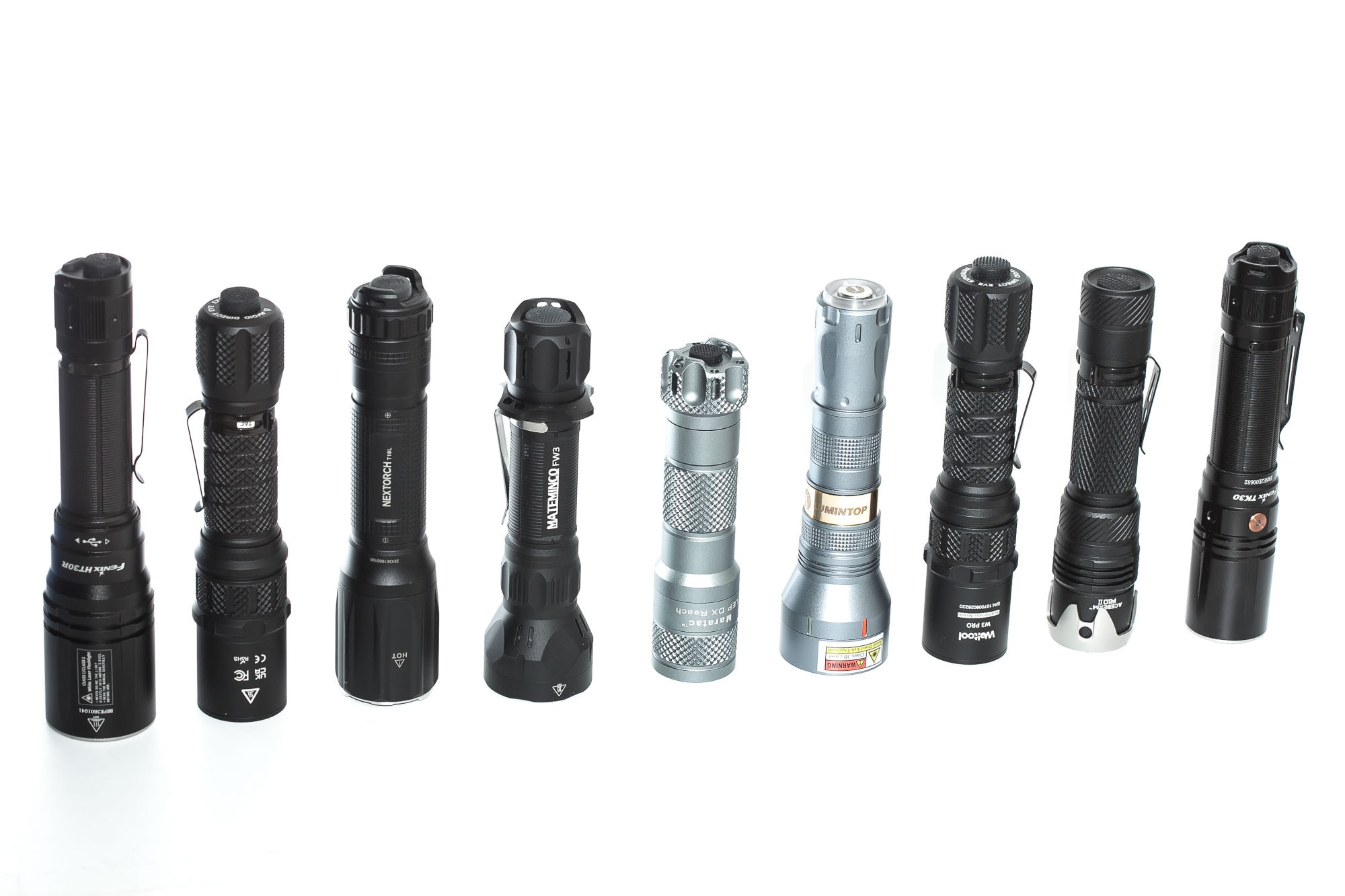
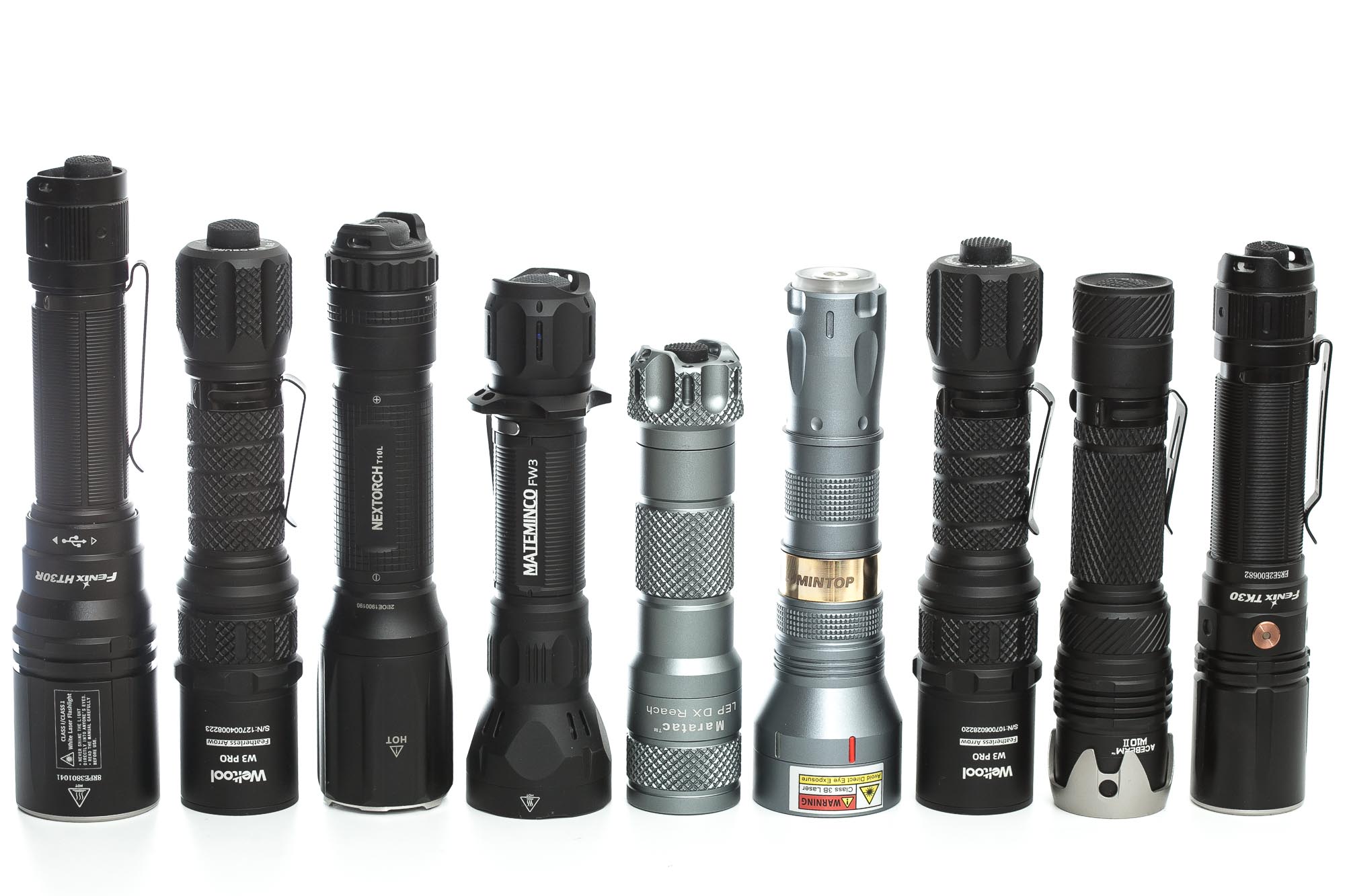
Maratac LEP DX Reach Rev2 UI : User interface and driver
The available main modes:
- Low, High
The available special modes (blinkies):
- Strobe
How the UI works when the flashlight is still turned OFF:
- Half-press: nothing
- Single-click: turns on in last used mode
How the UI works when the flashlight is turned ON:
- Half-press: Cycle between Low and High
- Single-click: turns off
- Double tap (thus not clicking): strobe
Shortcuts within the UI:
- None
Mode memory:
- Yes, it memorizes the last used mode
Blinky modes:
- There is a strobe mode, that can be accessed from On with a double tap (not double click).
Low battery warning:
- There is some blinking going on when the battery runs low.
Lock-out mode:
- There is none, and not necessary. Just use the mechanical switch to turn the light off
PWM:
- Not visible by eye
Firmware / UI Conclusion:
- The UI is simple with 2 modes. However, I would have liked Strobe to be activated with 3 or 4 taps, and not just 2.
Maratac LEP DX Reach Rev2 Charging and batteries
The Maratac can be used with 21700 batteries, as well as 18650 batteries with the included battery adapter. However, you can’t use long 21700 batteries, and I would highly recommend against trying.
So, either use a flat top, unprotected 21700, and if you really want to have that extra layer of protection, use a 18650 battery with protection instead.
The battery voltage after use is around 2.98V, and therefore is protected from undervoltage. This is important for good quality flashlights, and great to see in this one.
There is no onboard charging, so you need to buy a 21700 battery charger, or get a 18650 battery with built in USB port for charging.

Performance test
This is the gear I use for testing:
| Gear | Purpose | Link to buy |
|---|---|---|
| Hagner E4-X | Measuring beam intensity (throw) | Inquire at Hagner.se |
| 2* Extech SDL400 | Lumens and logging runtimes | Amazon.com, Amazon.co.uk, |
| Leica Disto D2 | Distance for throw measurements | Amazon.com, Amazon.co.uk, |
| Sekonic C-800 | Spectrometer for LED measurements | Amazon.com, Amazon.co.uk |
| Uni-T UTi260B | Thermal Image camera | Amazon.com, |
Lumen measurements:
How Lumens are Measured: Understanding ANSI FL1 Standards How Lumens are Measured: Understanding ANSI FL1 Standards: The ANSI FL1 standards specify that output in lumens should be measured 30 seconds after turning on, as this is the standardized time for measuring brightness according to the industry standard. This is why we focus on this part in our measurements. The ANSI FL1 standards require an ambient temperature of 22 ± 3°C. We record the ambient the ambient temperature to identify potential reasons for any observed discrepancies.The output measurements in this review are based on my homemade integrating spheres, each equipped with an Extech SDL400 Lux Meter. For consistency and accuracy, a calibration light (Convoy S2+ with 249lm and a Convoy S2+ with 261lm) is measured prior to each set of lumen measurements.
For high-output lights, one of the lux meters uses an ND camera filter to prevent the lux meter to max out. This is either the Kenko PRO1D ND16 up till about 80,000 lumens or Gobe ND32 for anything above.
All of my readings were taken from a fully-charged Samsung 50G battery
The measurements were taken manually at turn on and 30 seconds. The 10 minute numbers are taken from the runtime graph.
| Mode | Specified outputs | at turn on | 30 seconds | 10 minutes |
|---|---|---|---|---|
| Low | 180 lm | 71 lm | 67 lm | 64 lm |
| High | 600 lm | 312lm | 291 lm | 104 lm |
As you can see, the numbers aren’t even close to what is being advertised. And I personally don’t like this type of exaggerations! I hope Maratac will fix this, and use trustworthy specifications next time round.
But, I have to say that lumen outputs isn’t the most important factor for LEP flashlights, because sometimes the beam distance is actually really good, even at lower lumens. So, read on to see if it can reach claimed distance.
Maratac LEP DX Reach Rev2 Battery life and runtime
How Runtimes are Measured: Understanding ANSI FL1 Standards About ANSI FL1 runtime standards: The runtime is measured until the light drops to 10% of its initial output (30 seconds after turning on). This does not mean that the flashlight is not usable anymore. The last column shows how long the light actually works till it shuts off. If there is a + symbol, it means that the test was stopped at that particular point, but the light was actually still running. This happens on certain occasions, with certain drivers, firmware, or batteries.The runtime test was done with the 50cm integrating sphere, with the Extech SDL400 data logging Lux Meter.
The battery used for these tests is the Samsung INR21700 50G, which is a high capacity battery with decent discharge capabilities.
| Mode | Specified runtime | Measured runtime (ANSI FL1) | Time till shut off |
|---|---|---|---|
| Low | 6h 18min | 7h 55min | 7h 55min |
| High | 2h 15min | 5h 24min | 5h 24min |

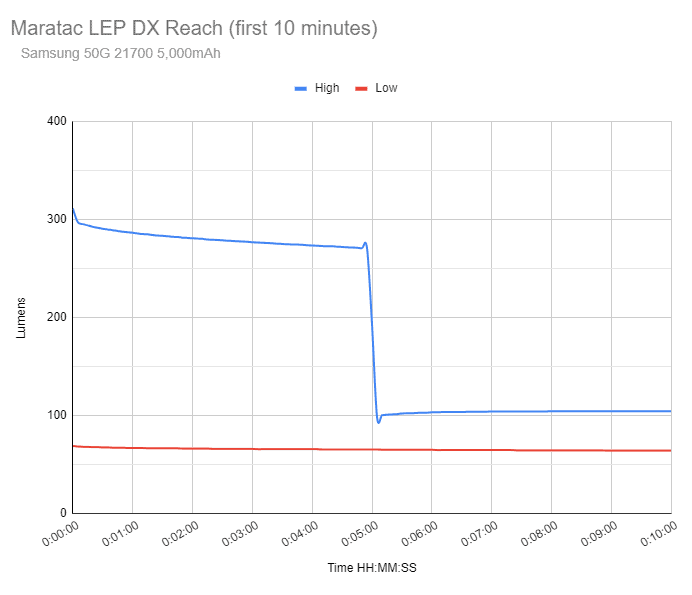
I feel like Maratac uses some bogus specifications without actually testing them. It’s probably tested with a 4000mAh battery, but that doesn’t explain the twice as long runtime on High mode.
Maratac LEP DX Reach Rev2 Peak beam intensity and beam distance measurements
About Peak beam intensity: Understanding ANSI FL1 Standards About peak beam intensity The calculated value of distance in meters at which the flashlight produces a light intensity of 0.25 lux. (0.25 lux is about the brightness of a full moon shining on an object). This means that the intensity has decreased so much, it becomes difficult to see darker objects, or objects that don’t reflect light. The columns ‘Meters’ and ‘Yards’ use rounded numbers.Measurements were taken outdoors at 20 meters with a Hagner E4-X Lux Meter. The measurements were done 30 seconds after turn on.
| Mode | Specified | Measured candelas | Meters | Yards |
|---|---|---|---|---|
| Low | – | 104,400 cd | 646 m | 707 yd |
| High | 895,000 cd | 396,000 cd | 1259 m | 1376 yd |
Also here we can see that it doesn’t reach the claimed beam intensity, or the 1.2 miles beam distance. And no, that’s not because I measured the intensity after 30 seconds, because the runtime also shows clearly that the output hasn’t dropped that much after 30 seconds yet.
LEP flashlight comparison: small LEP flashlights (< 40mm)
A comparison list with single-cell LEP flashlights we reviewed: These numbers are NOT from the specifications but measured by our reviewers. They include all single-cell LEP flashlights with a smaller diameter head (smaller than 45mm). The numbers include the measurement in lumens (lm), measure candela (cd), and calculated distance in meters, and yards. These numbers are all measured 30 seconds after turning on.
| Flashlight | @30sec (lm) | Candela (cd) | Meters | Yards |
|---|---|---|---|---|
| Acebeam W10 gen2 | 474 | 496,000 | 1409 | 1540 |
| Fenix TK30 | 493 | 384,000 | 1239 | 1355 |
| Fenix HT30R | 474 | 700,000 | 1673 | 1830 |
| Jetbeam M2S WP-RX | 354 | 345,000 | 1175 | 1285 |
| Jetbeam RRT M2S Raptor | 365 | 248,000 | 996 | 1089 |
| Lumintop Thor 1 | 323 | 356,000 | 1193 | 1305 |
| Lumintop Thor 2 | 324 | 888,000 | 1888 | 2065 |
| Lumintop Thor 2 v2 | 297 | 752,000 | 1734 | 1897 |
| Maratac LEP DX Reach rev. 2 | 291 | 396,000 | 1259 | 1376 |
| Nextorch L10 Max | 421 | 440,000 | 1327 | 1451 |
| Nextorch T7L | 524 | 428,000 | 1308 | 1430 |
| Nextorch T10L | 468 | 484,000 | 1391 | 1522 |
| Olight Odin Turbo | 379 | 368,000 | 1213 | 1327 |
| Richfire SFC-039 | 194 | 197,896 | 890 | 973 |
| TrustFire T30R | 105 | 147,500 | 768 | 840 |
| Weltool W3 Pro | 478 | 363,000 | 1206 | 1319 |
| Weltool W3 PRO TAC | 1017 | 583,600 | 1528 | 1671 |
Interactive runtime graphs below
Below are interactive throw comparison graphs (candela), between single-cell LEP flashlights with a small head (+-<40mm). Hover your mouse over the interactive graph below to see the details of each specific light.
(tip: hold your mobile phone horizontally to see the full graph). Or check this link to view the full interactive graph.
Same, but then focused on the first 30 minutes. Or open new window for 30min interactive graph here.
And now zoomed in to see the details. Or open the following link for the interactive graph.
Beamshots
For the following beamshots, I used a Canon EOS 5D mk2 with a 100mm lens. Manual settings: ISO1600, 0.5sec, F4, 5000K
The tower is about 450 meters / 492 yards away.
Here’s the list of lights compared:
- Maratac LEP DX Reach Rev2
- Fenix HT30R
- Natfire SF2
- Mateminco FW3
- Tank007 PTL01
- Amutorch BT35
Please note that beamshots are mainly intended to showcase the beam pattern and beam quality, rather than overall performance. These images are typically taken directly after activation, and do not fully represent its overall performance. For accurate performance metrics, such as output, beam distance, and runtimes, you need to look at the performance section of this review.
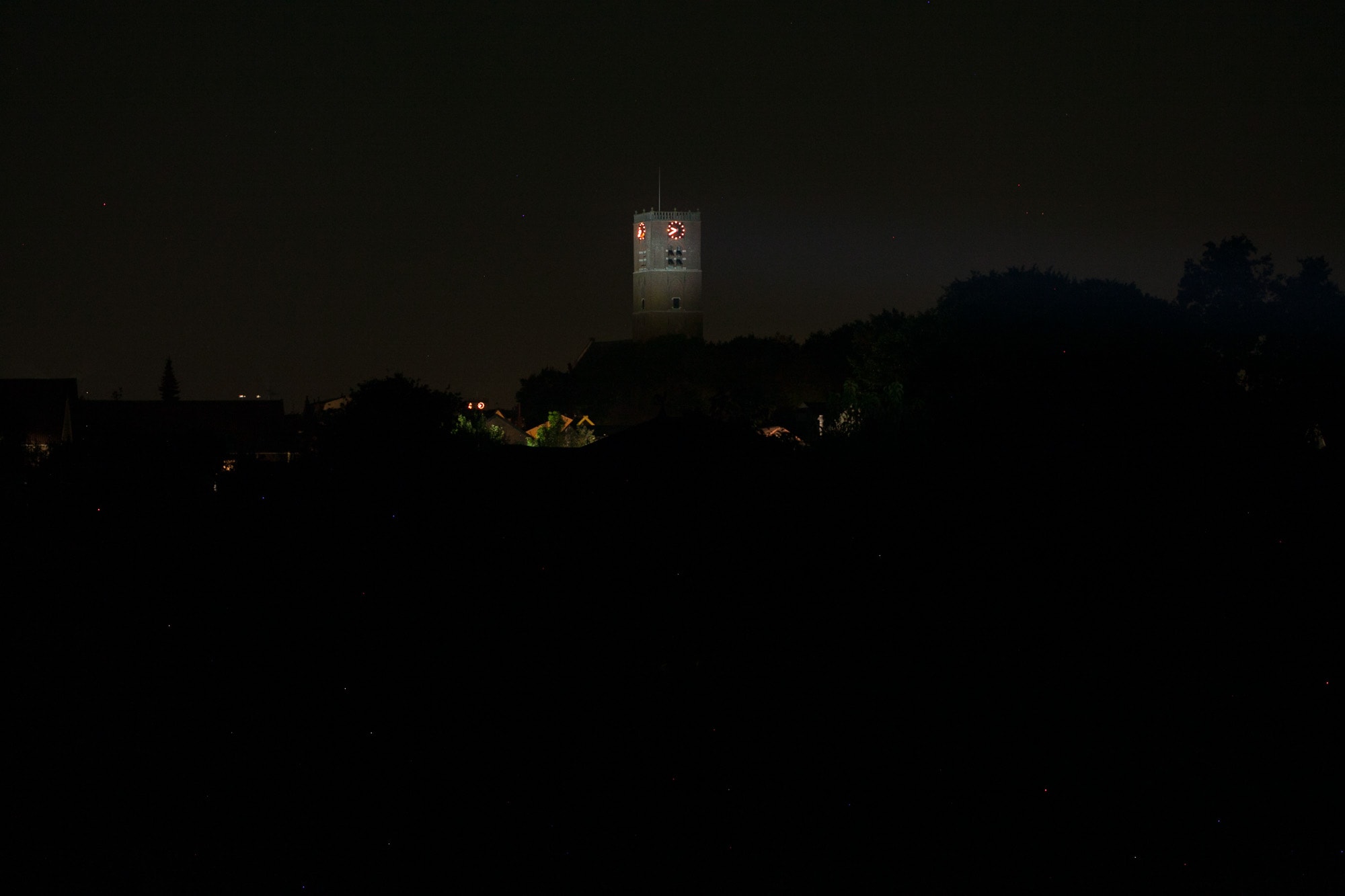
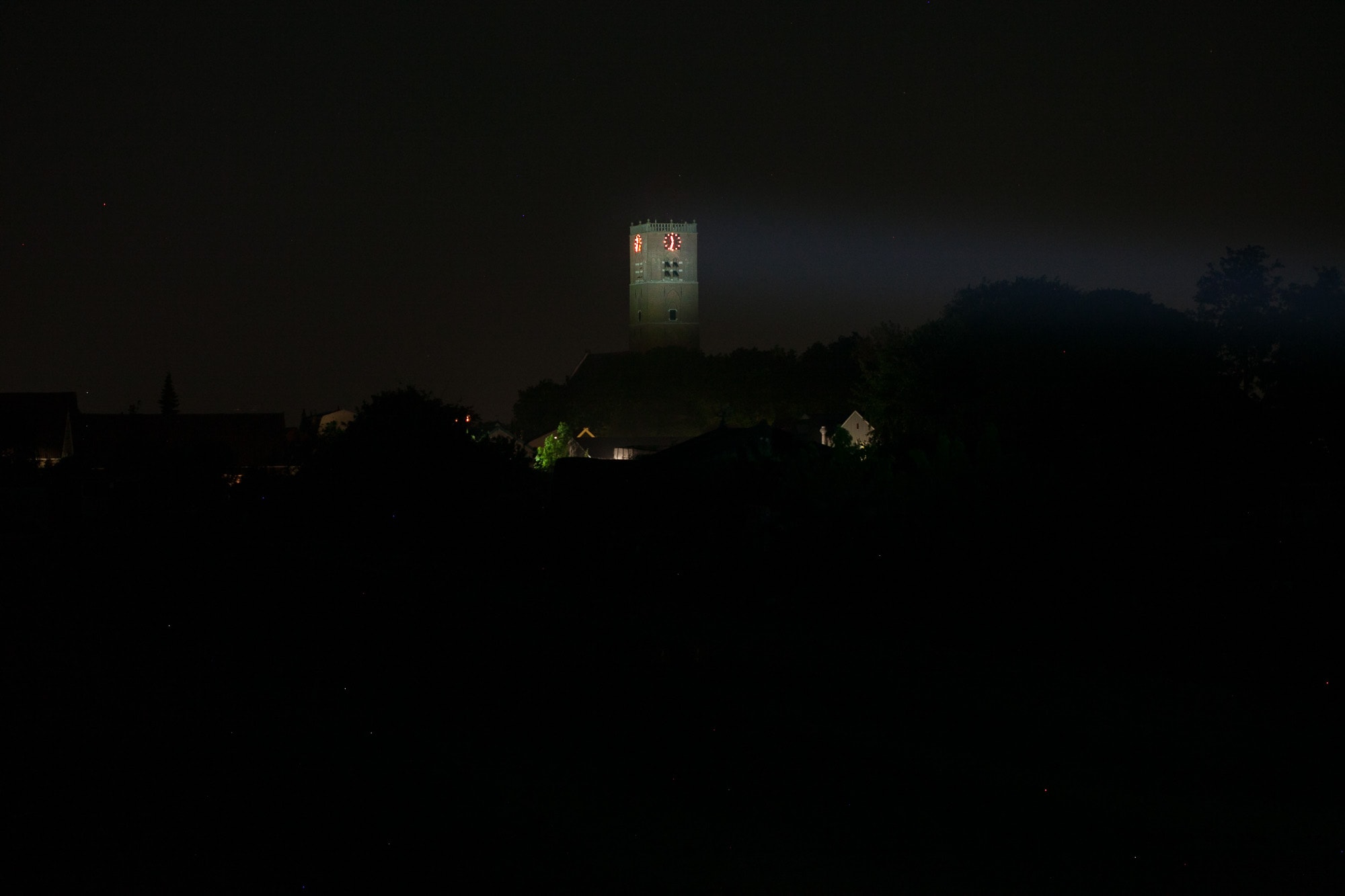
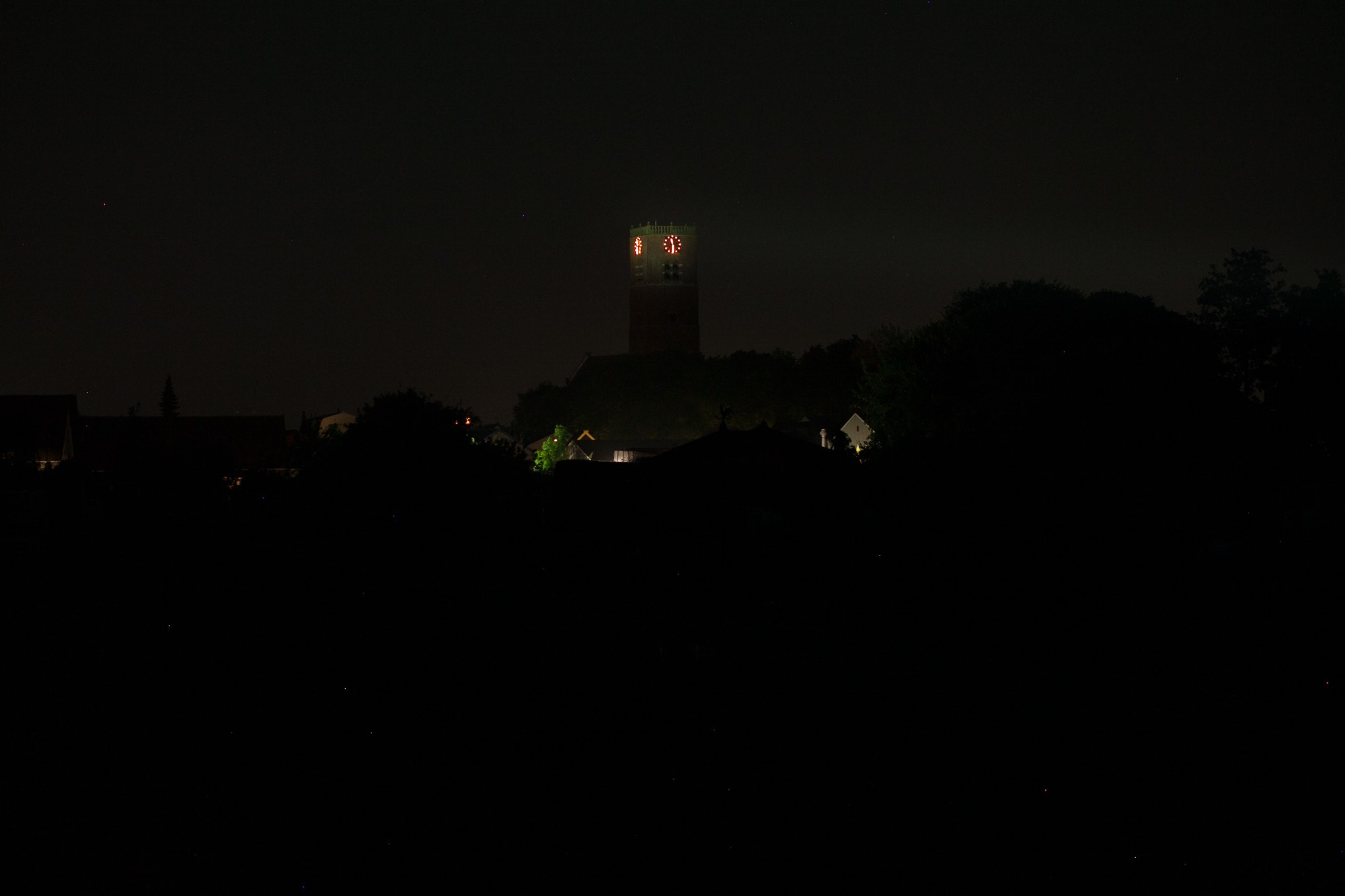

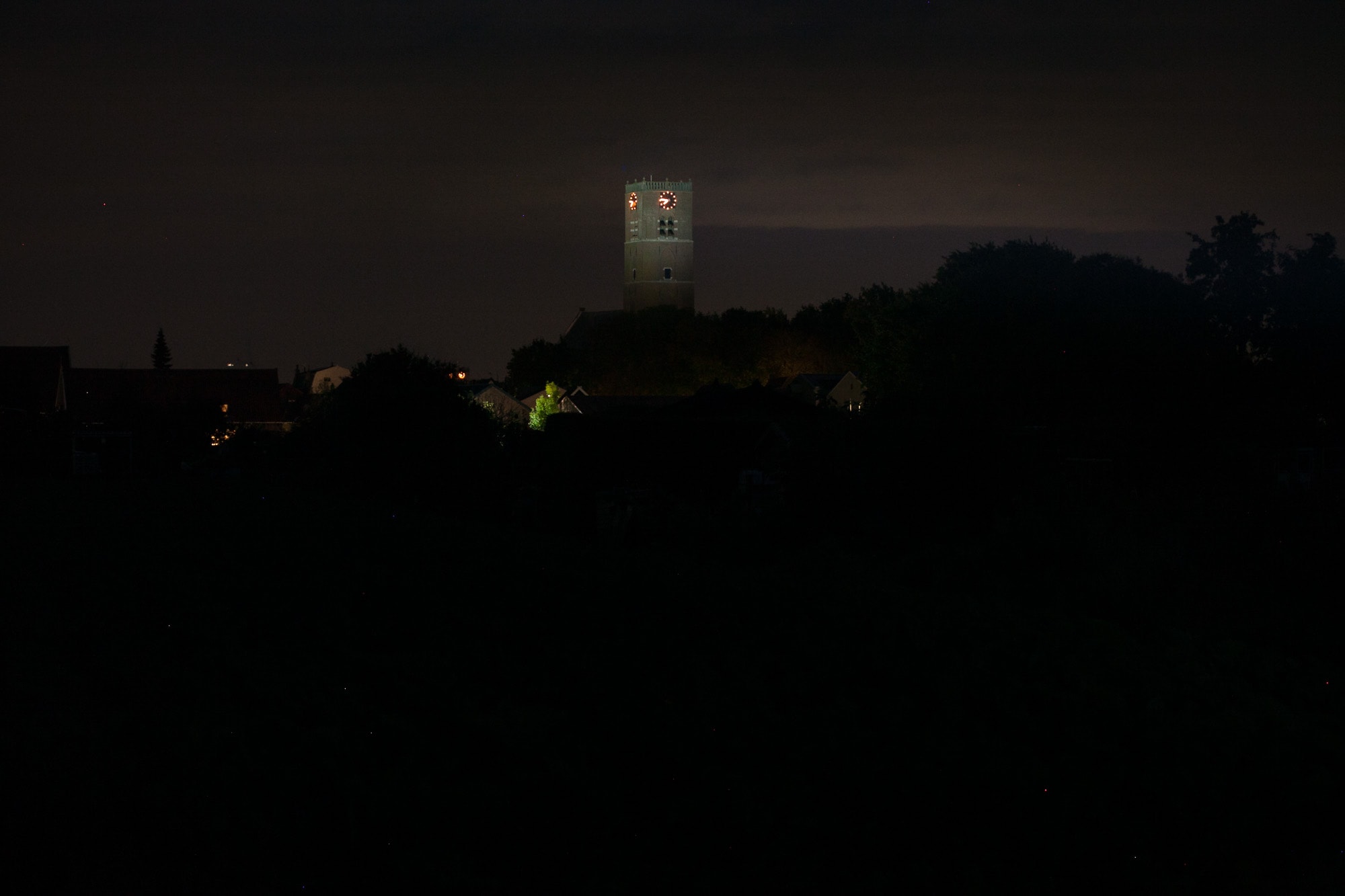
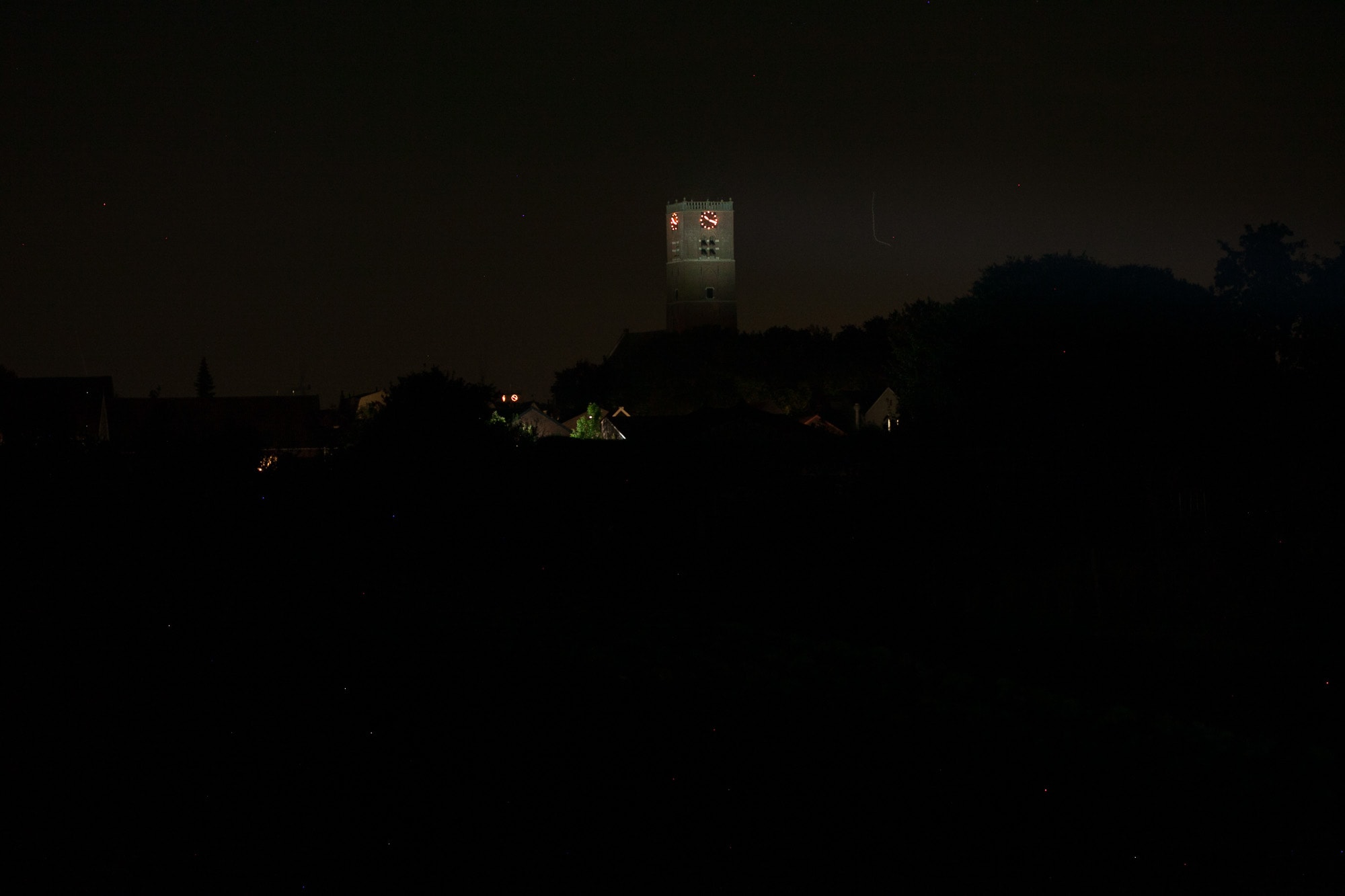
Disclaimer: I bought this flashlight with my own money. Nobody paid me to review this flashlight, nor have I been holding back on problems or defects.
Final Verdict
Pros
- Aggressive knurling for better grip
- Simple UI with 2 modes
- Nice color coating
- One of the shortest 21700 LEP flashlights on the planet
- Removable/replaceable LEP module
- Protective lens in front of the convex lens
- Affordable
Cons
- Not reaching claimed lumen output
- Not reaching claimed beam distance
- Big drop in output after 5 minutes
- Activates strobe a bit too easily with 2 taps. I recommend using 3 or 4 taps instead.
Explanation on star ratings:
1: Avoid: my phone flashlight would be a better choice – 2: Poor: significant defect or issues; almost unusable – 3: Average: some defects or issues; but still usable 4: Good: recommended (minor issues) – 5: Great: highly recommended
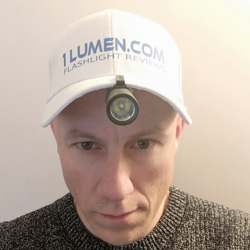
4 stars: ★★★★
While our star rating provides a reliable indicator, we encourage you to read the full review to make an informed decision based on your own needs and preferences.
There are some characteristics of this light, making it stand out from the other offerings. And this include the removable LEP module, simple UI, and being one of the shortest 21700 LEP flashlights on the planet.
Just these pros would make it worth considering, when looking for an LEP flashlights. Especially if you use it for only short bursts, shorter than 5 minutes, and not run it for longer periods of time.
However, it’s not all roses. And this is something I personally don’t like about this light, and that’s the exaggerated specifications. This is not good, and I would like Maratac to revisit their specifications and be more truthful. It could also be said for most of their other flashlight products.
This could easily be 4.5 stars if it would just do what it said. The lower score is mainly to show the disapproval over highly inflated specifications. The cons regarding the UI going into Strobe mode doesn’t have to be an issue because you will get used to the UI. But, the big performance drop after 5 minutes, and exaggerated claims reduces its score by at least 1 star.
Buy your Maratac LEP DX Reach Rev2 here
1lumen selects and reviews products personally. We may earn affiliate commissions through our links, which help support our testing.